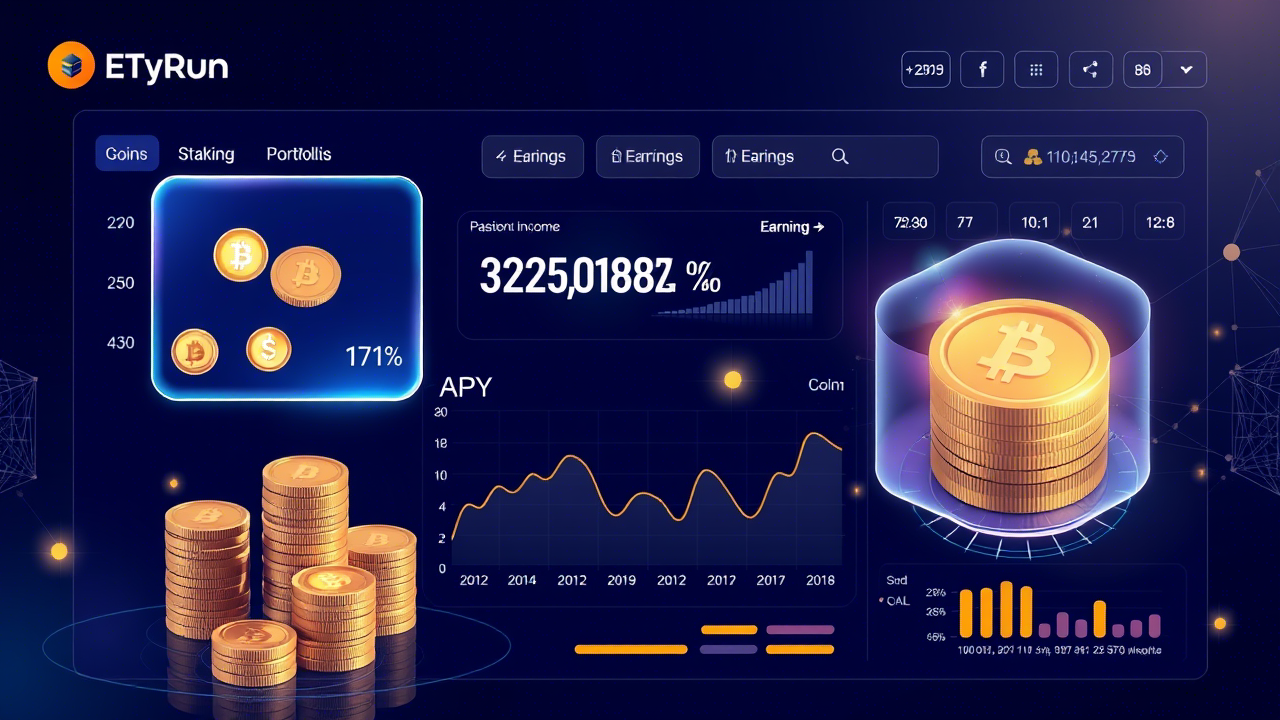The world of crypto investment has transformed from a niche digital experiment to a mainstream financial opportunity that millions of Indians are exploring today. With the Indian crypto market witnessing unprecedented growth and regulatory clarity emerging, understanding crypto investment has become essential for anyone looking to diversify their financial portfolio. Crypto investment represents more than just buying digital coins; it’s about participating in a revolutionary financial ecosystem that operates independently of traditional banking systems. Whether you’re a college student with ₹100 to invest or a working professional planning long-term wealth creation, the crypto market offers opportunities that weren’t available to previous generations. The beauty of crypto lies in its accessibility. Unlike traditional investments that often require substantial minimum amounts, you can start your crypto journey with as little as ₹100. This democratization of investment opportunities has opened doors for millions of Indians who previously felt excluded from wealth-building opportunities.
Understanding Crypto Investment Basics
What Makes Crypto Different from Traditional Investments
Crypto operates on blockchain technology, creating a decentralized financial system that doesn’t rely on banks or government institutions. This fundamental difference means your crypto investments aren’t subject to the same regulations and limitations as traditional banking products. The 24/7 nature of crypto markets means you can buy, sell, or trade digital assets at any time, unlike stock markets that operate during specific hours. This flexibility appeals to working professionals who want to manage their investments outside traditional market hours. Volatility in crypto markets creates both opportunities and risks. While prices can fluctuate dramatically within hours, this same volatility has created millionaires from modest investments. Understanding this balance is crucial for successful crypto investment.
The Indian Crypto Landscape
India’s approach to crypto has evolved significantly, with the government introducing a 30% tax on crypto gains and a 1% TDS on crypto transactions. Despite these regulations, Indian investors have embraced crypto investment as a legitimate asset class. Major Indian exchanges like WazirX, CoinDCX, and ZebPay have made crypto accessible to millions of Indians. These platforms offer user-friendly interfaces, educational resources, and customer support in regional languages, making crypto investment more approachable for beginners. The Reserve Bank of India’s stance on crypto continues to evolve, but the fundamental infrastructure for crypto investment in India remains robust. Understanding these regulations helps you make informed decisions about your crypto investment strategy.
Getting Started with Your First Crypto Investment
Setting Your Investment Goals
Before making your first crypto investment, define clear financial goals. Are you looking for short-term gains, long-term wealth building, or portfolio diversification? Your goals will determine your investment strategy and risk tolerance. Consider your financial situation honestly. Crypto investment should only involve money you can afford to lose completely. Never invest borrowed money or emergency funds in crypto, as market volatility can result in significant losses. Start with a small amount to learn the basics. Many successful crypto investors began with investments as small as ₹500 to ₹1,000, gradually increasing their positions as they gained experience and confidence.
Choosing Your Investment Amount
The question “Can I invest ₹100 in crypto?” has a simple answer: absolutely. Most major crypto exchanges allow investments starting from ₹100, making crypto accessible to students and young professionals with limited budgets. Financial experts recommend the 5-10% rule for crypto investment. This means limiting your crypto investments to 5-10% of your total investment portfolio. This approach helps manage risk while still allowing participation in potential high returns. Consider dollar-cost averaging for your crypto investment strategy. Instead of investing a lump sum, invest a fixed amount regularly, weekly or monthly, to reduce the impact of market volatility on your investment.
Selecting the Right Crypto for Beginners
Bitcoin: The Original Digital Currency
Bitcoin remains the most popular choice for beginners entering crypto investment. As the first and most established digital currency, Bitcoin offers relative stability compared to newer altcoins and has widespread acceptance among merchants and institutions. Bitcoin’s market dominance and regulatory acceptance make it a safer entry point for crypto investment beginners. Major companies like Tesla, MicroStrategy, and Square have added Bitcoin to their balance sheets, validating its long-term potential. The limited supply of Bitcoin (21 million coins) creates scarcity that many investors find appealing. This scarcity, combined with growing adoption, forms the foundation for Bitcoin’s long-term value proposition.
Ethereum: The Smart Contract Platform
Ethereum represents the second-largest crypto by market capitalization and offers unique value through its smart contract functionality. Unlike Bitcoin, which primarily serves as digital money, Ethereum powers decentralized applications and financial services. For beginners interested in understanding blockchain technology beyond simple transactions, Ethereum provides exposure to the broader crypto ecosystem. Many other digital currencies operate on the Ethereum blockchain, making it a fundamental part of the crypto infrastructure. Ethereum’s transition to Proof of Stake consensus mechanism has improved its energy efficiency and scalability, addressing common concerns about crypto’s environmental impact.
Exploring Other Beginner-Friendly Options
Cardano, Solana, and Polygon represent newer blockchain platforms that offer different approaches to solving crypto’s scalability and efficiency challenges. These alternatives provide diversification opportunities within your crypto investment portfolio. Binance Coin (BNB) and other exchange tokens offer unique benefits like reduced trading fees and access to exclusive investment opportunities. These tokens can provide additional value for active traders and investors. Stablecoins like USDC and USDT provide stability within the volatile crypto market. While they don’t offer the same growth potential as Bitcoin or Ethereum, they serve as useful tools for managing risk and maintaining purchasing power.
Building Your Crypto Investment Strategy
Long-term Investment Approach
Long-term crypto investment, often called “HODLing” in crypto communities, involves buying and holding digital assets for extended periods regardless of short-term price fluctuations. This strategy has proven successful for many early Bitcoin and Ethereum investors. The long-term approach requires patience and conviction in the underlying technology. Successful long-term crypto investors focus on fundamental analysis, studying the technology, adoption rates, and real-world use cases rather than short-term price movements. Research suggests that crypto investors who hold their investments for at least four years typically see positive returns, despite the market’s volatility. This timeline aligns with Bitcoin’s four-year halving cycles, which historically correlate with major price movements.
Short-term Trading vs. Long-term Investing
While short-term trading can be profitable, it requires significant time, skill, and risk tolerance. Beginners often find more success with long-term crypto investment strategies that don’t require constant market monitoring. Day trading crypto requires understanding technical analysis, market psychology, and risk management. The 24/7 nature of crypto markets can make short-term trading particularly demanding and stressful for beginners. Consider your lifestyle and available time when choosing between trading and investing. If you have a full-time job and limited time for market analysis, long-term investing typically offers better risk-adjusted returns.
Risk Management in Crypto Investment
Understanding Market Volatility
Crypto markets are significantly more volatile than traditional financial markets. Daily price swings of 10-20% are common, and major digital currencies can lose or gain 50% of their value within weeks. This volatility creates opportunities for significant gains but also poses substantial risks. Successful crypto investors learn to manage their emotions during market downturns and avoid making impulsive decisions based on short-term price movements. Market volatility affects different digital currencies differently. Bitcoin and Ethereum typically show less volatility than smaller altcoins, making them more suitable for risk-averse beginners.
Diversification Strategies
Diversification within crypto investment involves spreading your investments across different types of digital currencies rather than concentrating on a single coin. This approach helps reduce risk while maintaining exposure to the overall crypto market growth. Consider diversifying across different categories: store of value coins (Bitcoin), smart contract platforms (Ethereum), payment currencies (Litecoin), and utility tokens (Chainlink). Each category serves different purposes and may perform differently during market cycles. Geographic diversification also applies to crypto. While focusing on globally recognized digital currencies, consider including tokens from different regions or those solving specific regional problems.
Security Best Practices for Crypto Investment
Choosing Secure Exchanges
Security should be your top priority when selecting a crypto exchange for your investments. Research the exchange’s security history, regulatory compliance, and insurance coverage for customer funds. Indian exchanges like WazirX and CoinDCX offer robust security measures including two-factor authentication, cold storage for customer funds, and regular security audits. These features protect your crypto investment from hacking attempts and unauthorized access. Avoid storing large amounts of cryptocurrency on exchanges for long durations. Use secure wallets for better protection. While exchanges provide convenience for trading, they also present security risks. Consider moving your long-term investments to personal wallets for enhanced security.
Wallet Security and Storage
Crypto wallets come in two main types: hot wallets (connected to the internet) and cold wallets (offline storage). Hot wallets offer convenience for frequent transactions, while cold wallets provide maximum security for long-term storage. Hardware wallets like Ledger and Trezor represent the gold standard for crypto security. These devices store your private keys offline, making them immune to online hacking attempts while still allowing you to transact when needed. Backup your wallet’s seed phrase securely and never share it with anyone. This 12-24 word phrase can recover your entire crypto investment if your wallet is lost or damaged. Store multiple copies in different secure locations.
Tax Implications of Crypto Investment in India
Understanding Crypto Taxation
The Indian government has established clear tax guidelines for crypto investment. Gains from crypto transactions are taxed at 30%, with no deductions allowed for expenses or losses from other investments. A 1% TDS (Tax Deducted at Source) applies to all crypto transactions above ₹10,000. This means exchanges automatically deduct 1% of transaction value and remit it to the government, which you can claim as credit against your tax liability. Maintain detailed records of all crypto transactions including purchase dates, amounts, and prices. This documentation is essential for accurate tax reporting and can help you optimize your tax obligations within legal boundaries.
Compliance and Record Keeping
Proper record-keeping for crypto investment includes tracking purchase prices, transaction fees, dates, and the purpose of each transaction. Many crypto tax software solutions can help automate this process. Consider the tax implications when planning your crypto investment strategy. Holding digital currencies for longer periods doesn’t change the tax rate, but it can help you optimize the timing of your transactions for tax efficiency. Consult with a tax professional familiar with crypto regulations to ensure compliance with Indian tax laws. The crypto tax landscape continues to evolve, and professional advice can help you navigate complex situations.
Common Mistakes to Avoid in Crypto Investment
Emotional Trading and FOMO
Fear of Missing Out (FOMO) leads many beginners to make impulsive crypto investment decisions. Buying during market peaks due to social media hype often results in significant losses when markets correct. Emotional trading based on daily price movements destroys wealth over time. Successful crypto investors develop discipline to stick to their investment strategy regardless of market euphoria or panic. Establish clear investment guidelines and follow them consistently. Decide in advance how much you’ll invest, when you’ll buy more, and under what conditions you might sell. This systematic approach helps prevent costly emotional decisions.
Lack of Research and Due Diligence
Investing in digital currencies without understanding their underlying technology, use cases, and market dynamics is essentially gambling. Successful crypto investment requires understanding what you’re buying and why. Avoid investing based solely on price predictions or social media recommendations. These sources can inspire ideas, but they should never substitute your personal research and evaluation. Beware of crypto scams and too-good-to-be-true investment opportunities. Legitimate crypto investment opportunities don’t promise guaranteed returns or require recruiting others to participate.
Advanced Strategies for Growing Your Crypto Investment
Dollar-Cost Averaging
Dollar-cost averaging involves investing a fixed amount in crypto at regular intervals regardless of market conditions. This strategy reduces the impact of volatility on your overall investment returns. For example, investing ₹5,000 monthly in Bitcoin over 12 months gives you a better average price than trying to time the market with a single ₹60,000 investment. This approach works particularly well for long-term crypto investment. Automate your dollar-cost averaging strategy using exchange features that allow scheduled purchases. This automation removes emotions from the investment process and ensures consistency in your investment approach.
Staking and Yield Farming
Staking allows you to earn passive income from your crypto holdings by participating in network validation. Many exchanges offer staking services for popular digital currencies like Ethereum, Cardano, and Solana. Yield farming is the process of supplying liquidity to DeFi platforms in return for earning rewards or interest. While potentially lucrative, yield farming carries additional risks including smart contract vulnerabilities and impermanent loss. Start with simple staking options offered by reputable exchanges before exploring more complex DeFi strategies. These basic staking opportunities can provide 5-15% annual returns on your crypto investment.
Monitoring and Managing Your Crypto Portfolio
Portfolio Tracking Tools
Professional portfolio tracking helps you monitor the performance of your crypto investment across multiple exchanges and wallets. Top crypto apps like CoinTracker, Blockfolio, and Delta provide comprehensive portfolio management features. Regular portfolio reviews help you rebalance your holdings and make informed decisions about future investments. Set monthly or quarterly review schedules to assess your crypto investment performance and adjust your strategy as needed. Track not just prices but also market developments, regulatory changes, and technological updates that could affect your investments. Staying informed helps you make better decisions about your crypto portfolio.
When to Rebalance
Rebalancing involves adjusting your crypto portfolio to maintain your desired allocation between different assets. As prices change, your portfolio allocation will drift from your original targets. Consider rebalancing when any single digital currency represents more than 50% of your total crypto portfolio, or when your total crypto allocation exceeds your target percentage of overall investments. Some investors rebalance on a schedule (monthly or quarterly), while others use threshold-based rebalancing (when allocations drift by specific percentages). Choose the approach that fits your investment style and available time.
The Future of Crypto Investment
Emerging Trends and Technologies
Layer 2 solutions, central bank digital currencies (CBDCs), and improved regulatory frameworks are shaping the future of crypto investment. Understanding these trends helps you position your portfolio for long-term success. Decentralized Finance (DeFi) continues to expand, offering new opportunities for earning yields and accessing financial services without traditional intermediaries. These developments could significantly impact the value of underlying blockchain platforms. Environmental concerns are driving innovation in energy-efficient blockchain technologies. Proof of Stake consensus mechanisms and carbon-neutral digital currencies may become increasingly important for ESG-conscious investors.
Institutional Adoption
Growing institutional adoption of crypto validates its long-term potential and could drive sustained price appreciation. Major corporations, pension funds, and even governments are adding digital currencies to their balance sheets. Traditional financial institutions are developing crypto services, making it easier for retail investors to access crypto markets through familiar channels. This institutional integration could reduce volatility and increase mainstream adoption. The development of crypto ETFs and other regulated investment products provides new avenues for crypto investment, particularly for investors who prefer traditional brokerage accounts over crypto exchanges.
Market Bubble Considerations
Understanding crypto bubble dynamics is crucial for long-term investors. While market bubbles create risks, they also present opportunities for those who understand market cycles and maintain disciplined investment strategies. Historical analysis shows that crypto markets follow cyclical patterns, with periods of rapid growth followed by corrections. Smart investors use these cycles to their advantage through strategic timing of their investments. Building wealth through crypto requires understanding both the technology and market psychology. The most successful investors combine technical knowledge with emotional discipline to navigate market volatility effectively.
Creating Wealth Through Long-term Vision
Building Generational Wealth
Wealth through long-term vision applies strongly to crypto investment. Early adopters of Bitcoin and Ethereum have created substantial wealth by maintaining conviction in revolutionary technology despite short-term volatility. The key to building wealth through crypto lies in understanding the technology’s transformative potential. Blockchain technology isn’t just about digital money; it’s reshaping entire industries from finance to supply chain management. Consider crypto as part of a broader wealth-building strategy that includes top stocks and other asset classes. Diversification across asset classes helps protect wealth while maximizing growth opportunities.
Passive Income Opportunities
Passive income ideas in crypto extend beyond simple price appreciation. Staking, lending, and yield farming offer ways to generate ongoing income from your crypto holdings. DeFi platforms provide opportunities to earn interest on crypto deposits, often at rates higher than traditional savings accounts. However, these opportunities come with additional risks that require careful evaluation. Creating multiple income streams with cryptocurrency can strengthen your long-term wealth management and financial security strategy. The key is starting early and maintaining consistent investment habits.
FAQ
Can I start crypto investment with just ₹100?
Yes, most Indian exchanges allow investments starting from ₹100, making crypto accessible to everyone regardless of budget size.
Which crypto is best for beginners?
Bitcoin and Ethereum are generally recommended for beginners due to their established track records, widespread adoption, and relative stability.
How much should I invest in crypto monthly?
Limit crypto to 5–10% of your total investment portfolio, adjusting based on your risk tolerance and financial goals.
Is crypto investment legal in India?
Yes, crypto investment is legal in India, though subject to 30% tax on gains and 1% TDS on transactions.
What’s the minimum time to hold crypto investments?
While there’s no minimum holding period, long-term investors (4+ years) historically see better risk-adjusted returns than short-term traders.
How do I protect my crypto investment from hackers?
Use reputable exchanges, enable two-factor authentication, store large amounts in hardware wallets, and never share your private keys.
Should I invest in multiple cryptos or focus on one?
Diversification across 3–5 different digital currencies can help reduce risk while maintaining growth potential in your investment portfolio.
What happens if I lose my crypto wallet?
Without proper backup of your wallet’s seed phrase, lost crypto is generally unrecoverable, emphasizing the importance of secure backup procedures.
Final Thought
Crypto investment represents a revolutionary opportunity to participate in the future of finance, but success requires education, patience, and disciplined risk management. Start small, focus on established digital currencies like Bitcoin and Ethereum, and gradually expand your knowledge and portfolio as you gain experience. The key to successful crypto investment lies not in timing the market perfectly, but in understanding the technology, managing risks appropriately, and maintaining a long-term perspective. Whether you’re investing ₹100 or ₹100,000, the principles of successful investing remain the same: research thoroughly, invest only what you can afford to lose, and stay committed to your strategy through market volatility. Remember that crypto investment is a marathon, not a sprint. The most successful crypto investors are those who started early, stayed consistent, and continued learning throughout their journey. Your crypto investment journey begins with a single step – take that step today with confidence, armed with the knowledge to navigate this exciting financial frontier.












Leave a Reply